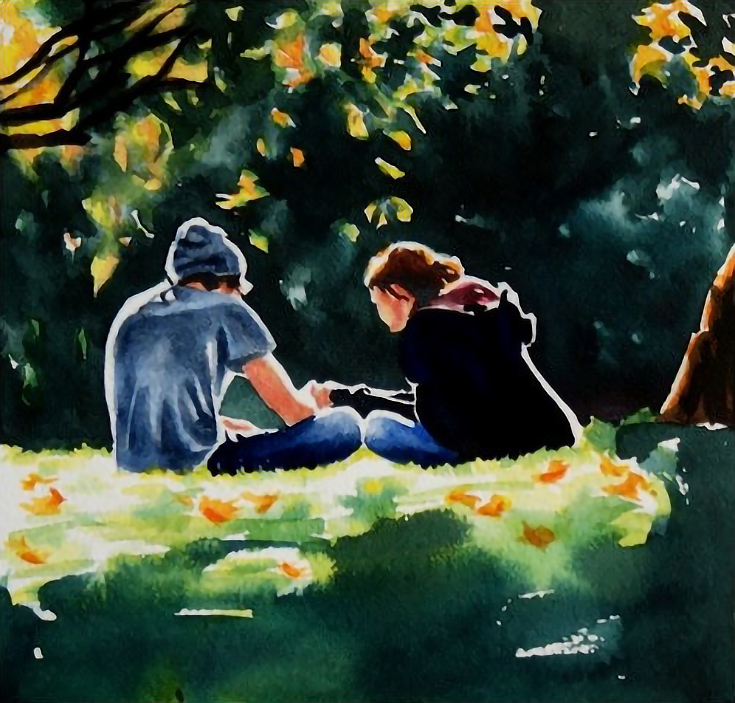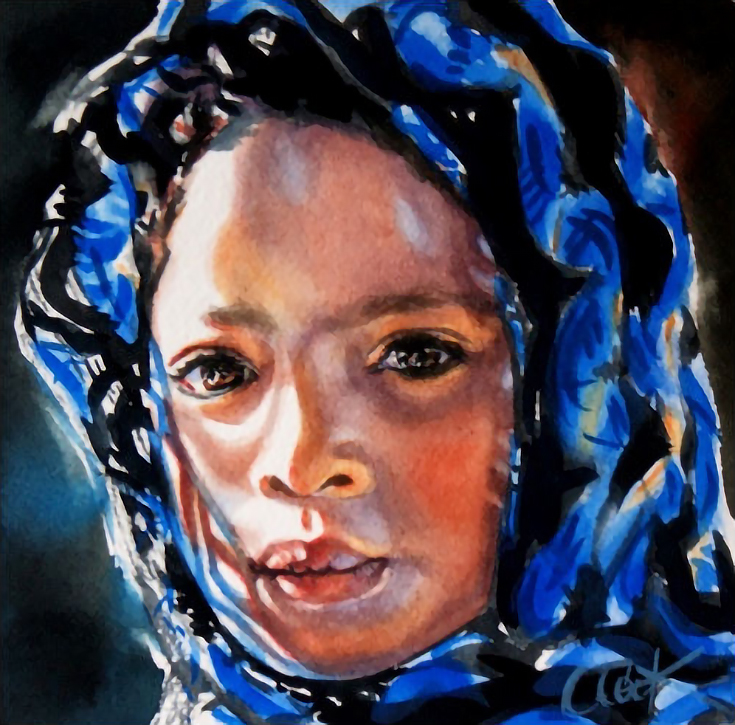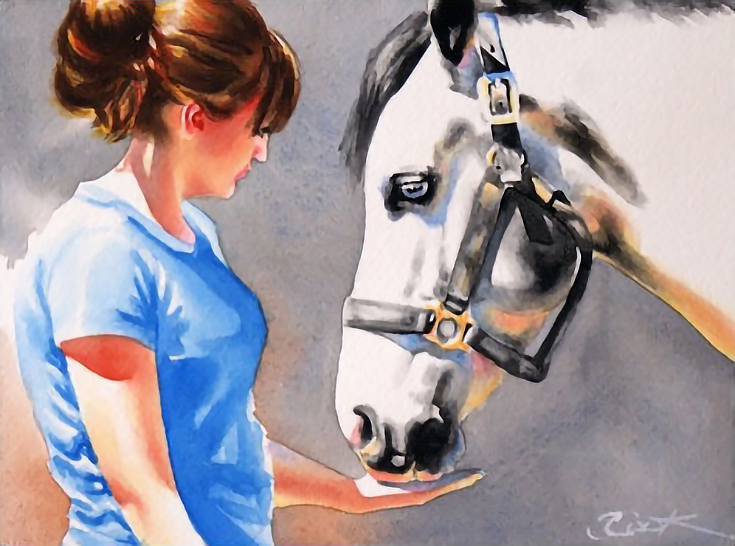
Today, Crystal has received many honors and awards through local, state, and national competitions, and has several pieces adorning the walls of museums and collectors alike.
Alyice: For those who are curious about how water-based paints can be permanent, can you explain what watercolor paints are and how they work?
Crystal: All paints essentially contain two main properties: pigment and binder.
With oil paints the binder is obviously some kind of oil, usually linseed oil. With watercolor paints, the binder is some kind of water soluble vehicle, which is usually a natural gum arabic.
Depending on the quality of watercolor paints that an artist uses, and the care that is given to frame and preserve the finished work they can be just as permanent as an oil painting. The pigments of both oil and watercolors are essentially the same, it’s only the binder, or the vehicle to get the paint onto the surface, that is different.
Watercolors are transparent and are usually painted on white paper, which creates a luminous glow that is unachievable with other mediums. The light of the white paper shines through the transparent layers of paint which makes colors very vibrant and intense.
Alyice: Why did you choose watercolor as your medium?
Crystal: When I was about thirteen years old my brother bought me a watercolor kit that came with a book filled with watercolor paintings done by lots of different artists.
There was one painting, in particular, that really caught my eye. It was a portrait of a red haired little girl sitting in the sun. There were colorful shadows cast across her face and the painting had that effortless look that showed the artist was a true master.
I can’t even begin to describe how I felt when I saw that painting, but it made me want to paint in a way that nothing else ever had. I had found what I wanted to do. I kept looking at that page in that book over and over again, almost wearing the book out, just absolutely amazed that anyone could paint like that. That’s when I fell in love with watercolor and I knew right then that I wanted to create that kind of a reaction in the viewers of my paintings.
Alyice: You’ve stated on your shop, that you like to create pieces that evoke emotion. How does one going about do that?
Crystal: For me it’s trying to be aware of how I feel in response to seeing something around me.
One day I took my kids to the park and it was one of those last beautiful days of fall right before the weather starts to get cold. The leaves on the trees were all golden or red, and the sun was getting ready to set.
I was pushing my son on the swings and I looked behind me and saw this young couple sitting under a tree with their bodies angled towards each other, hands and knees just slightly touching. It looked like they were just beginning to fall in love and that image stuck with me so that I simply could not forget it, I knew I had to paint that scene.
While I was painting it, I kept thinking of that couple, and then of how it felt for me when I first fell in love.
I think that when an artist feels that kind of a response to something around them and then follows through with trying to express those emotions in paint, in some way, you can’t help but evoke emotion in the people who will see the finished work. I think the key to evoking emotion with your paintings is being emotionally invested yourself, as the artist, in whatever it is you’re painting and trying your best to communicate that through the way you paint.
Alyice: A lot of your pieces are created as “close ups” rather than landscape or whole scenes, what do you think close-ups offer that the latter don’t?
Crystal: I love the intimacy that close-ups provide, giving us that little look closer into who someone, or what something really is.
I think seeing someone’s face up close makes it nearly impossible for that person to hide any emotion he/she might be feeling. Painting a person that way feels more honest to me, more real, and I really love that.
It’s one of the reasons I love to paint children so much too. There is candor in a child’s expressions that simply isn’t there anymore when we become adults and I love trying to capture that in paint. I think that painting any subject up close provides viewers with a new way of seeing things, I think it helps to reveal beauty and sincerity that might be hidden or easily obscured from far away. And also I just love painting details, it’s exciting to me.

Alyice: Your shop listings often tell a story about the painting. How important is it for you to tell the story?
Crystal: I am very emotionally involved in my paintings, as I’m sure most artists are, so for me telling the story that inspired the painting is just another way for me to express the emotion I felt when I wanted to paint that particular subject in the first place.
I absolutely think that other artists should give more thought into sharing stories that go along with their paintings. It helps viewers, buyers, and collectors become more emotionally involved in the work as well, so that in a way they feel like they are going through the experience with you.
I had one of my collectors tell me once that it was what I wrote about the piece that made the decision for them to buy the painting. They saw the painting and felt something when they saw it, but then reading my thoughts and feelings made them feel something even stronger, it connected them to the work on a whole different level.
I think that only good things can come from artist’s sharing their stories about their paintings in words as well as paint.
Alyice: What is the most challenging part about working with watercolors?
Crystal: Timing.
Painting successfully with watercolors is all about the timing. There’s a very limited amount of time that you have to manipulate the paint and coax it into the place you want it to end up. Watercolor is the only art medium that I know of that moves independently when you place it on the paper. For an inanimate object it has an alarming amount of free will.
Alyice: What is the best part about working with watercolors?
Crystal: Those spontaneous moments where the paint, water, and paper did something entirely different than what you wanted it to, but you ended up liking it better than what you had planned out in the first place. Most watercolor artists live for those happy accidents. They are a thing of beauty.
Alyice: What do you wish you knew about watercolors before you got started?
Crystal: That it isn’t nearly as easy to paint a beautiful, spontaneous-looking painting as it seems. Remember that painting of the red haired little girl I talked about earlier? The one I said looked like it was painted by a true master? Well, I thought that once I had some paints and water I’d be able to paint that effortlessly too, no sweat. Admittedly I was just thirteen, but still, talk about a disappointment when it didn’t happen that way!
Watercolor had a very steep learning curve for me, but once I figured out how it worked I was in love and have been ever since.
Alyice: How durable are your finished pieces?
Crystal: My finished pieces are very durable when they’re given proper care and framing.
The paints I use to create my paintings have the highest possible lightfast ratings. I also spray my paintings with a light coat of a UV protective coating and I mount them to a piece of acid free foam core board. This is both for extra stability during shipping, and also so that when they arrive to my buyers they are immediately ready to frame.
Watercolors do need a little extra attention when they are being framed. . . for example, archival and acid free mats should always be used for extra protection and I also recommend that they use UV protected glass, and that the painting is never hung in direct sunlight. But if you follow these tips the artwork will remain in excellent condition for many, many years.
Alyice: What is your creative process like?
Crystal: It usually starts with the spark of an idea, an image I’ve seen somewhere, whether it’s a color scheme, or the way the light falls on a subject, or the texture of something, or maybe a story I want to tell. Then I look for reference photos, and if I can’t find anything suitable for my idea that I already have I stage my own photo shoot, sometimes even using myself as a model.
Then I work up a drawing, trying to be as expressive as I can with my lines and shapes. Next, I start painting. . . I lay in what I call a foundation, which is just a thin layer of color that defines the contours and shape of my subject. After that, I layer thin glazes of paint one on top of another until I achieve the color saturation and value strength that I’m after.
I like to listen to music while I paint, and my dogs like to keep me company and sleep at my feet while I’m working.
Alyice: What do you believe is a key element in creating a good composition?
Crystal: Knowing where you want the focal point to be, where you want the viewer’s eye to linger, and making sure that every stroke you lay down on the paper is a path that is leading the viewer’s eye to that spot. And I think going with your gut—your own artistic intuition—and breaking some rules if you feel they need to be broken, can lead to some of the most exciting compositions ever.
Learn more about Crystal at her website, CrystalCookArt.com.
This post may contain affiliate links.


